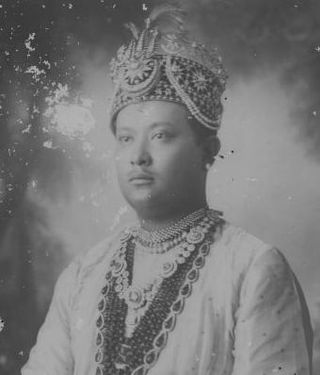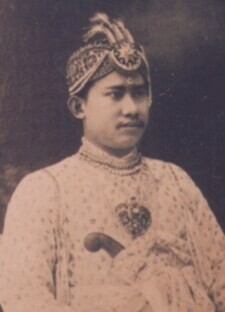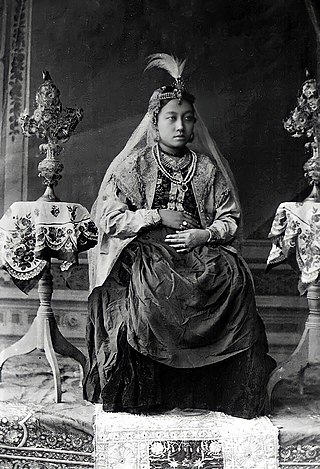Related Research Articles

Tripura is a state in Northeast India. The third-smallest state in the country, it covers 10,491 km2 (4,051 sq mi); and the seventh-least populous state with a population of 3.67 million. It is bordered by Assam and Mizoram to the east and by Bangladesh to the north, south and west. Tripura is divided into 8 districts and 23 sub-divisions, where Agartala is the capital and the largest city in the state. Tripura has 19 different tribal communities with a majority Bengali population. Bengali, English and Kokborok are the state's official languages.

Agartala is the capital and the largest city of the Indian state of Tripura, situated on the banks of Haora/Saidra River, about 2 kilometres (1.2 mi) east of the border with Bangladesh and about 2,499 km (1,552 mi) from the national capital, New Delhi. According to 2022 AMC data, Agartala is the second most populous city after Guwahati in Northeast India. It is India's third international internet gateway and being developed under the Smart Cities Mission.

Kokborok (or Tripuri) is a Tibeto-Burman language of the Indian state of Tripura and neighbouring areas of Bangladesh. Its name comes from kok meaning "verbal" and borok meaning "people" or "human", It is one of the ancient languages of Northeast India.
Khumulwng is a town in the West Tripura district in the Indian state of Tripura. It is the headquarters and the largest town of the Tripura Tribal Areas Autonomous District Council.

Tripura University is a central university, the main public government university of Tripura, India.

The Tripuri are a Tibeto-Burman-speaking ethnic group of Northeast Indian state of Tripura. They are the descendants of the inhabitants of the Twipra/Tripura Kingdom in North-East India and Bangladesh. The Tripuri people through the Manikya dynasty ruled the Kingdom of Tripura for ~450 years until the kingdom joined the Indian Union on 15 October 1949.
Drama was brought into the Kokborok-speaking population by the Yatra (Jatra) performers of Bengal. The rulers of Independent Tripura were the first to present and perform drama in Tripura. Though in the beginning the presentations of yatras (jatras) were limited to the Royal Compound, in course of time it came out of the royal compound and mass people also began to enjoy it and join it.

The Assam State Museum, previously Assam Provincial Museum, is located in the southern end of Dighalipukhuri tank which is in the heart of Guwahati city, Assam. The Museum was established by the Kamarupa Anusandhan Samiti in 1940. The late Kanaklal Barua was the founder and president. In the year 1953, it was taken over by the Assam State Government.

Maharaja Bir Bikram Kishore Manikya Debbarma Bahadur was a king of Tripura State.

Ujjayanta Palace is the state museum of the Indian state of Tripura and former royal palace of the princely state of Tripura. It was built by Maharaja Radha Kishore Manikya in 1901. It housed the State Legislative Assembly up to 2011. The palace primarily showcases the lifestyle, arts, culture, tradition and crafts of communities residing in northeast India, along with many stone sculptures of the Manikya dynasty.
Kailashahar is the fourth largest urban area in the north eastern state of India, Tripura, located near northwest Bangladesh border. It is a Municipal council and the administrative center of the Unakoti district, this city is surrounded by unakoti hills and flows through Tripura's longest river, Manu.

Birendra Kishore Manikya Debbarma Bahadur ascended the throne of the Kingdom of Tripura on 25 November 1909, at the age of 26.

Maharaja Radha Kishore Manikya of the Manikya Dynasty reigned as the king of Tripura State from 1897 to 1909. He has been described as one of the architects of modern Tripura.
Atul Debbarma is an Indian doctor-turned-politician and author. He was a practicing doctor in the Municipal Corporation of Delhi until December 2017. He became involved with Rashtriya Swayamsevak Sangh (RSS) and its different wings such as Vanvasi Kalyan Ashram and Vivekananda International Foundation in 2007. He won the Tripura Assembly Elections 2018 as the BJP candidate from Krishnapur constituency.

Vijaya Manikya II, also spelt Vijay or Bijoy, was the Maharaja of Tripura from 1532 to 1563. Succeeding to the throne at a young age, Vijaya proved himself to be a formidable military leader, initiating a series of conquests into several surrounding kingdoms, including the powerful Bengal Sultanate. During Vijaya's reign, the might and influence of Tripura reached its zenith, leading to him being viewed as one of its greatest monarchs.
Lakshman Manikya was the Maharaja of Tripura during the mid-18th-century, though he maintained little actual power, having acted only as a puppet-monarch under Shamsher Gazi.

Maharani Khuman Chanu Manmohini Devi was the third Maharani consort of Tripura through her marriage to Maharaja Birchandra Manikya. She was a contemporary royal photographer who choreographed her self-portraits with the Maharaja and was considered the first Indian woman who mastered the art of photography.
Tribal Research and Cultural Institute was established under Tribal Welfare Department in the year 1970 as per the decision of the Government of India. It is dedicated to conduct research on tribal issues and also evaluate the various programmes'/schemes' impact on the tribes residing in Tripura.

Tripura is a state in the North-East India and the third smallest state in India. Tripura is widely regarded as a beautiful destination, appreciated for its picturesque landscape and delightful climate. The tourism in Tripura is maintained by TTDCL, a state government owned enterprise.
References
- ↑ "Website of Tripura State Tribal Museum| National Portal of India". www.india.gov.in. Retrieved 2022-08-22.
- ↑ "Tripura State Tribal Museum (Agartala) - 2022 What to Know Before You Go (with Photos)". Tripadvisor. Retrieved 2022-08-22.
- ↑ "Interesting - Review of Tripura State Tribal Museum, Agartala, India". Tripadvisor. Retrieved 2022-08-22.
- ↑ "Tripura State Tribal Museum | , India | Sights". www.lonelyplanet.com. Retrieved 2022-08-22.
- ↑ "Tripura State Tribal Museum | Agartala". indiamap.com. Retrieved 2022-08-22.
- ↑ "Myth Interactives | 360° Tour, Tripura State Tribal Museum" . Retrieved 2023-04-11.